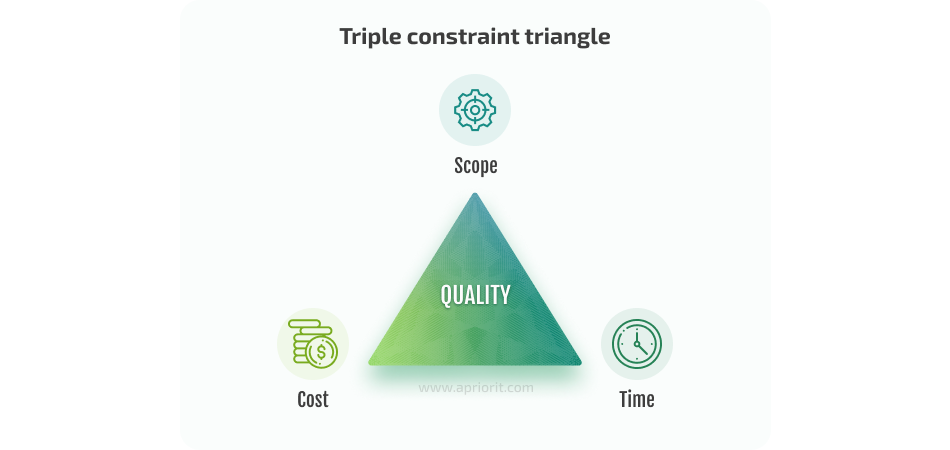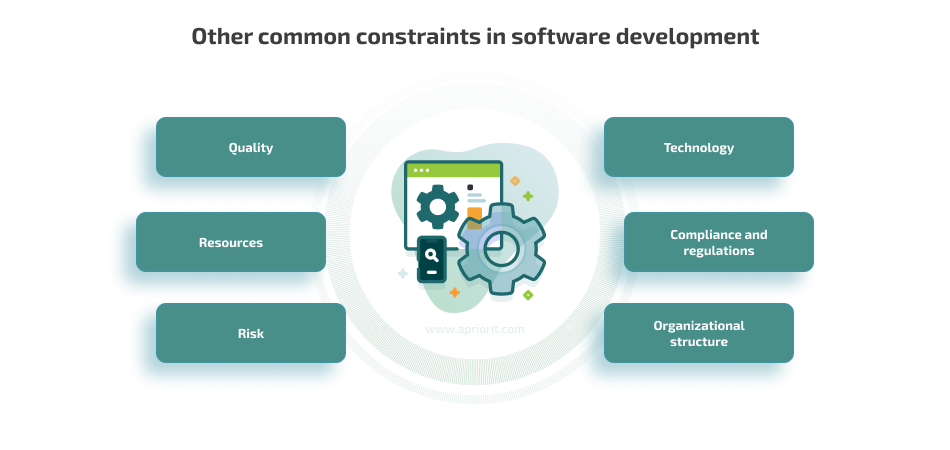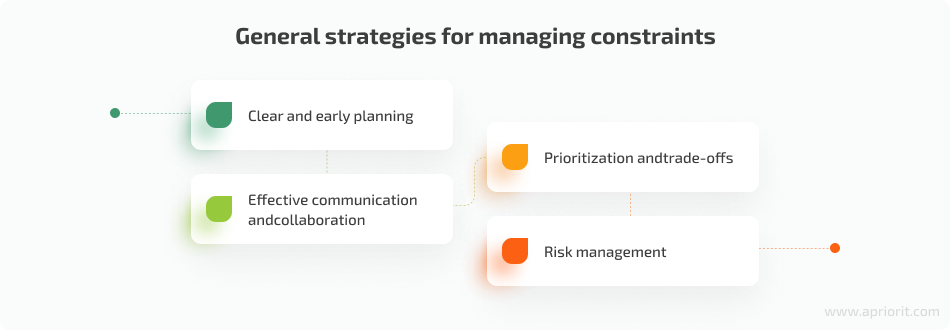All software development projects have resource limitations. Whatever the size or profitability of your business, there will always be limits to a project’s time, scope, or budget. Yet, delivering a quality product under various constraints is possible. All you need to do is thoughtful consideration and strategic management to effectively handle constraints in software development and shape the trajectory of development.
In this article, you will learn how project managers can navigate various software development constraints that might derail your product. You will also discover practical methods that will help your team manage the most common project limitations and explore specific approaches of Apriorit experts to handling time, scope, and cost constraints.
This article will be useful for product owners, product managers, and stakeholders who need to reach their software project goals regardless of limitations.
Contents:
What are project constraints in software development?
The theory of constraints in software development identifies possible bottlenecks within a system’s overall performance. You can apply the same principles to the software development process. Project constraints include various limiting factors that impact the software development process, including tangible and intangible elements of your project.
Budget, time, and resource (material) constraints are the usual suspects, dictating how much you can spend, how fast you can build, and what resources you have to complete the project. But the list doesn’t end here. Client expectations, market fluctuations, and even technology limitations (non-material constraints) can all play a role. Basically, these constraints define the boundaries within which a development project operates, influencing everything from resource allocation to technical aspects of your project.
Effective management of project bottlenecks is crucial for successful project delivery. At Apriorit, we explore many possible scenarios during the research and discovery phase. If your business faces unique constraints or specific project conditions, our project managers and business analysts will carefully consider and calculate associated risks during the planning phase.
Constraints vs dependencies: what’s the difference?
Any project has its dependencies and constraints, and both can cause delays, budget overruns, and other issues that harm product delivery. Understanding the difference between constraints and dependencies is essential for project planning.
- Dependencies are interconnected tasks in a project, where the completion of one task is a prerequisite for starting another. As each project is essentially a chain of tasks, many tasks will have dependencies. Overlooking dependencies during planning can lead to delays and management issues. Dependencies can eventually bring more constraints or even risks if they are ignored.
- Constraints are mostly resource-related and pertain to the project’s initial requirements. Deadlines, scope, and required skills impose limitations on project planning and resource allocation. As a result, anything that limits your project implementation is a constraint. A large number of dependencies can be a constraint in itself, so you need to plan your project thoroughly.
In the next sections, we focus on various types of project constraints and their impact on development. By understanding and effectively managing these constraints, software development teams can navigate challenges without compromising the quality of their deliverables.
Uncertain about how to prioritize features with limited resources?
Let our experienced project management team help you navigate your software development constraints!
The iron triangle of software development constraints
There are three major constraints that are present in each project and influence all other constraints that might follow. They are called the iron triangle, or the triple constraints of project management. The iron triangle is a framework showing the delicate balance between these three fundamental constraints:

Each component plays a unique role, and their synergy is key to project success. Scope defines features, cost governs finances, and time sets the pace for delivery. Let’s take a look at each of them.
- Scope refers to the breadth and depth of features and functionalities incorporated into the software. It defines the boundaries of the project, outlining the project’s specific capabilities.
- Cost represents the financial investment allocated to various aspects of software development, including initial development, necessary resources, and ongoing maintenance. Cost includes financial investments in not only the software itself but also labor, vendors, quality control, tools, etc.
- Time dictates the deadlines for project delivery and establishes key milestones throughout the development process. This also includes the project’s schedule and the time at which each part of the project should be completed, including final delivery.
Each component of the project management constraints triangle plays a unique role in shaping the development process, and they are interdependent. This means that changing one component inevitably affects the others:
- Scope vs cost. The features and functionalities outlined in the scope directly impact the allocated budget. Expanding the scope may inflate costs, which requires careful consideration and trade-offs.
- Cost vs time. The budget directly influences the resources allocated and the pace at which development can progress. Rushing development to meet deadlines may escalate costs, while excessive budget constraints can impede progress.
- Time vs scope. The project’s timeframe influences the depth and complexity of the features outlined in the scope. Meeting deadlines may necessitate prioritizing certain features or adopting an iterative approach. Extending the timeline to accommodate a comprehensive scope may affect the project’s overall time to market.
Understanding the nuanced implications of scope, cost, and time is essential for project success. However, there are many other constraints that are not directly part of the iron triangle. Let’s explore what other constraints can impede your project development.
Read also
Techniques for Estimating the Time Required for Software Testing
Learn how you can combine different software testing estimation techniques and methods, taking into account the specifics of the project at hand and the testing team.
Additional constraints in software projects
In addition to the primary constraints of scope, cost, and time, effective software development might be hindered by various other factors.

- Quality. Quality is one of the major constraints that is present in any software project. It depends heavily on all parts of the constraint triangle. Quality considerations in software development include adherence to industry standards, robust testing processes, and meeting user expectations.
- Resources. Effective software development depends on various resources, including personnel, expertise within the team, the availability and functionality of software tools, and infrastructure, such as server capacity and network capabilities. Managing these resources requires careful planning and allocation to ensure optimal project outcomes.
- Risk. Project risks can include all potential pitfalls and uncertainties during planning and development. Risks can manifest in various forms, including scope changes, unforeseen technical challenges, or external factors beyond the team’s control. Expert project managers can help you identify, assess, and mitigate risks before they become a huge problem. Apriorit experts recommend taking a proactive approach to risk management, which allows us to respond promptly, minimize disruptions, and ensure project continuity.
- Technology. Every software development project introduces its own set of technical constraints, including existing systems, limitations of chosen technologies, and compatibility issues. Integrating with legacy systems or adhering to specific technological standards might lead to additional spending or longer time estimates. Your project managers and business analysts need to consider the capabilities and limitations of chosen technologies for informed decision-making.
- Compliance. This includes adhering to data protection laws, industry standards, and any specific regulations applicable to the project. If your team is unable to comply with these constraints, you will most likely face legal repercussions, financial penalties, and damage to the project’s reputation.
- Organizational structure. The structure of the company and its internal processes can influence project efficiency. Bureaucracy, rigid hierarchies, and lack of autonomy can stifle innovation and slow down decision-making. As these constraints can’t be addressed without project delays, it’s always best to choose an outsourcing company that streamlines processes, empowers teams, and fosters a culture of collaboration and agility.
Market trends, technological advancements, economic fluctuations, and even natural disasters can also impact project timelines, resource availability, and user needs. To successfully navigate these interconnected constraints, you need to ensure strategic decision-making, adaptability, and effective communication throughout the entire development lifecycle. Now, let’s see how you can manage these constraints so they don’t hinder project development.
Related project
Improving a SaaS Cybersecurity Platform with Competitive Features and Quality Maintenance
Explore how we improved the competitiveness of our client’s SaaS cybersecurity platform by adding new features and enhancing the overall UI/UX experience.

Practical strategies for effective constraint management
Even though project constraints can hinder progress and threaten your project’s success, your team can still mitigate them in a timely manner. Through the application of meticulous planning, strategic decision-making, and insightful methodologies, your project managers and business analysts can not only manage constraints but turn them into catalysts for future optimization.
Proven tips from Apriorit experts
To effectively deal with various possible software development constraints, you need to take a strategic and proactive approach. Based on Apriorit’s 20 years of experience, we have outlined several proven techniques that can guide teams through the challenges of addressing possible constraints.

Clear and early planning. To succeed in managing constraints, start thinking about them early on. This means your project managers and business analysts should accurately define the project requirements and scope, leaving no room for confusion. Set realistic budgets and schedules, and don’t forget to add a buffer for unexpected challenges. This will help you create a strong foundation for your project. Also, using agile methodologies makes development flexible and adaptable to changing project dynamics in the long run.
Effective communication and collaboration. Keep communication transparent between all stakeholders to make sure that everyone understands the project goals. Effective internal communication can have a great impact on project cohesion and success. To keep everyone on the same page, your project managers can encourage teamwork in problem-solving as well, implementing a system of shared responsibility and using collaboration tools.
Prioritization and trade-offs. This means identifying critical features and prioritizing them to use resources efficiently. Your project managers need to be ready to make informed trade-offs between scope, schedule, and budget to ensure effective project management. Prioritizing quality throughout, with continuous testing and feedback loops, contributes to delivering strong end products.
Risk management. Proactively managing risks minimizes potential challenges. Identifying risks early allows the development of strategies to mitigate their impact. Your team can achieve a resilient end product by implementing proactive measures to reduce the effects of potential challenges. With the help of monitoring tools and contingency plans, you can get quick responses, help the team effectively navigate risks, and maintain project momentum.
Now, let’s take a look at more specific strategies when dealing with the triple constraints of project management.
Read also
Software Requirements Specification – A Must for Any IT Project
Find out how expert business analysts can help you deliver complex projects within the estimated time and budget with the help of a software requirements specification.
Time constraint management
Time constraints in project management revolve around deadlines and the development schedule determining when each project part should be delivered. Accurately predicting timing is harder for larger projects, so estimating the final delivery date is one of the biggest challenges of project management.
To accurately estimate timing, Apriorit project managers use a multitude of methodologies and consider risks and unexpected situations that can occur during the project. To manage time constraints effectively, your team can follow these tips:
- Plan dependencies meticulously by defining main goals and securing resources before the project starts.
- Schedule tasks realistically, considering potential risks and leaving a buffer for unexpected situations.
- Constantly monitor progress, using historical data for retrospectives and improvements.
- Maintain control over the development process, addressing issues proactively.
- Implement time management frameworks and tools such as Gantt charts, critical path analysis, and PERT for efficient planning and prioritization.
Scope constraint management
The project scope, defined during a discovery phase, outlines business goals, requirements, and processes. The scope is usually documented in a technical specification that describes every detail of the project, from features and functionality to third-party integrations and the technology stack.
Of course, as development goes on and business goals change, the scope can change as well. Project managers refer to this as scope creep — when unexpected changes in the middle of development hinder the project’s overall progress. Here are steps you can take to manage scope creep in project management:
- Keep documentation clear and comprehensive to avoid miscommunication.
- Establish a change management procedure to prevent delays and confusion.
- Maintain regular communication with stakeholders to ensure alignment with business needs.
- Prioritize tasks for optimization, focusing on essential features for initial development.
Cost constraint management
The cost of a project includes all expenses including for labor, taxes, hardware, materials, recruiting, and paid third-party services. The project cost is calculated during the estimation process, after the scope is defined during the discovery phase. Here is how you can manage cost constraints on your project:
- Use historical data to predict project costs based on recent similar projects.
- Estimate resources for each task, closely linking resource management with cost considerations.
- Plan for additional spending, such as on licensing, devices for team members, work trips, and so on.
- Compare vendor bids, averaging them to determine the typical cost for similar projects.
Read also
Business Analyst Roles & Responsibilities in Software Development
Find out how adding an expert business analyst to your team can assist in the delivery of high-quality products.
Conclusion
Effectively managing time, scope, cost, and other constraints in software development is a burden for every project. However, these issues are possible to handle when you have experienced project managers and business analysts who take a comprehensive approach. Key actions to take are integrating strategic planning, setting project goals based on documentation, and proactively communicating throughout the software development lifecycle.
At Apriorit, our project managers and business analysts take all constraints into account during both the discovery phase and each project iteration. Clear communication, detailed requirement analysis, and thorough planning are how we make sure constraints don’t get in the way of timely delivery and achieving your business goals.
Ready to turn project constraints into opportunities?
Ensure your software development success with our comprehensive project management and business analysis services.





